March 2003
Dolly Partons,
Twiggies, And Broad Band Topés
Or ……. Via con Autopista, amigo, y via con Dios!
When last we spoke, dear readers, we were anxiously awaiting the day to cross the border into Mexico, ready to start our new adventure. Well … we came, we saw, and we emerged unscathed. Our excursion south of the border was full of new sights and experiences, and we had a great time. We definitely plan to return again next winter, for a longer period, and see new areas. But we are wiser now, and know more of what to expect; and it’s not all wonderful. Mexico is a country of contrasts, and we experienced many of them.
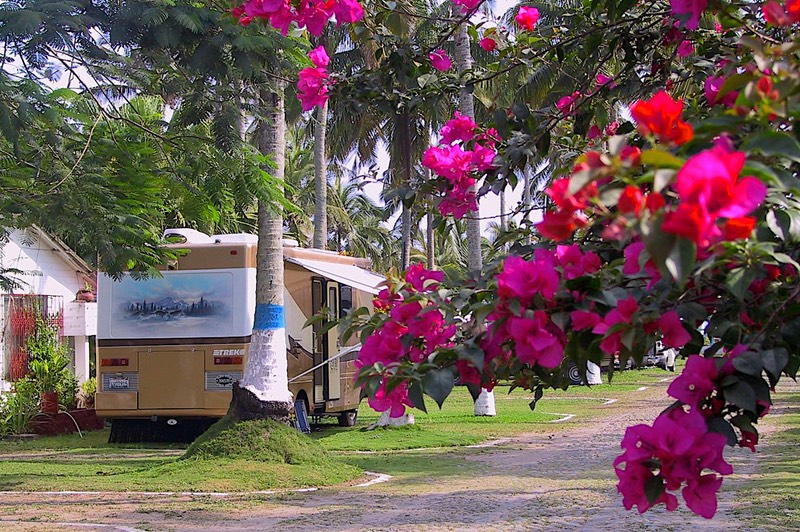
You may remember that we gathered ourselves in Livingston Texas, preparing for our trip. We left our trailer and motorcycle there, along with other items to lighten the load and make room for souvenirs and whatever else might come our way. We then traveled south, south to Laredo, through Texas, the land of “guard rail damage” signs along the freeway; what does that mean? Crash at your own risk? We saw our first Jack in the Boxes (Jacks in the Box?) since it seemed like forever; Rick wanted to stock up with food to take across the border, but I wouldn’t let him. Remember? We were going to Mexico, the land of Mexican food, which he loves. Yeah, right.
While still in Texas we made a stop at Goliad State Historic Park. Important things happened here during the Texas war for independence, and there is a nice state park, where we spent the night. Goliad contains a splendid church from that era, which had been in ruins until rebuilt during the 1930s as a WPA project. They did a wonderful job, and we enjoyed a morning wandering the site, which has been left very rural and evocative of the early 1800s. The church, a mission church, reminded us of San Luis Obispo, as we were to be reminded many times over the next few weeks during our time in Mexico. As noted, this church was part of the missionary effort by the Spanish, and interestingly, it was in this area that the Spanish introduced cattle into the Mexican territories; up until then the Indians had existed without beef. Think about it…….
Oh, yes; it was here that the cats saw their first jack rabbit and that REALLY got their attention!
Our crossing in Laredo was uneventful, if somewhat stupid. The Mexican authorities haven’t a clue about efficiency or proper signage, so you really are sort of “hat in hand” as you cross the border and try and find the proper place to go to get your paperwork handled. But eventually we finished, and our group of six rigs headed south. There were 28 rigs in all that left together from Laredo, heading to the rally site north of Mexico City (part way down we connected with a larger group that had entered from New Mexico), and we traveled in small groups in order not to take up too much of the road at one time. We had never traveled in a group before, and the dynamics were interesting; nuff said. We won’t be doing that again soon! But we did make good friends with several of the couples in our group, and will stay in touch.
As you move south from the Laredo area, the countryside is very similar to southern Texas, Arizona and California: cattle ranches, more and more cactus (in bloom! It’s spring!), dusty and dry. The sage brush (or maybe it’s broom) was in bloom as well.
Rick is going to talk about the roads………..say something nice, Rick; you know you can…………explain about the Dollie Partons, Twiggies and Broad-band Topes.
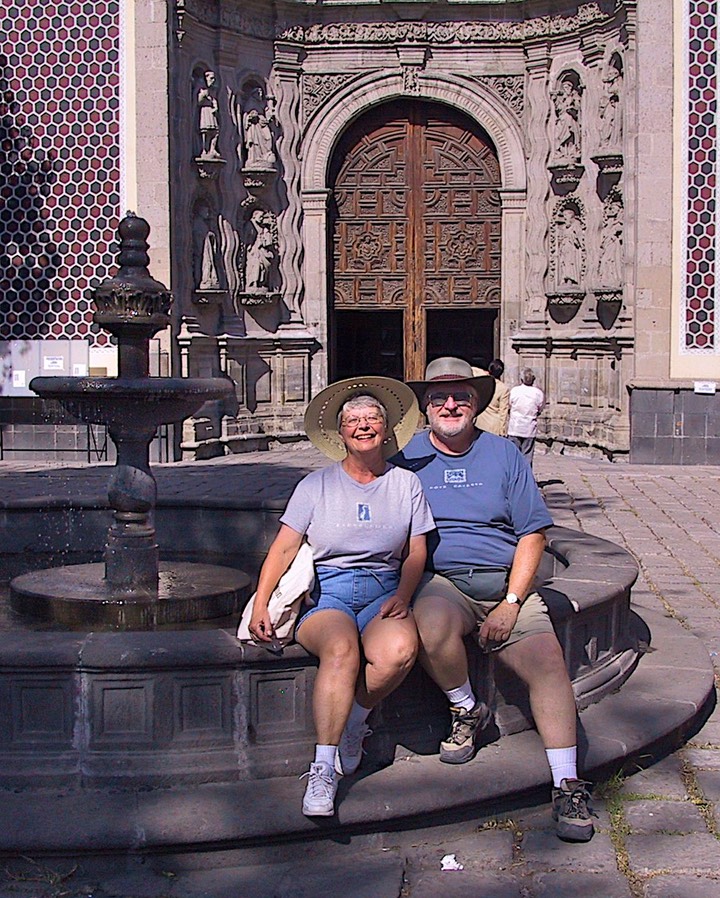
Ah, yes; The Roads. Anyone thinking of driving in Mexico hears about the roads: their condition, the cost of the tolls, the truckers, the signage, etc. Well, we are here to tell you that whatever you may have heard about Mexican roads, it’s probably true. Some of the new cuota (toll) roads are amazingly good; as good as anything we see in the states. Some of them are not so good, and some of them are so expensive to drive on that you expect to see gold showing through the pavement. In one instance, we paid as much to travel a twenty-five mile segment as we paid to go just about the whole length of the Pennsylvania turnpike; and we were a short rig with no other vehicle in tow. One of our group members was charged more than twice as much as we were due to the number of axles on their combined vehicles. Some of the libre (free) roads were also very, very good. But some of them were… well, let’s just say that I cannot clearly describe them in what is, after all, presumed to be a family publication. Overall, the lack of decent shoulders on the two lane roads would have to be my biggest complaint (well, that and the topés – more on those below). Often the road just dropped off at the edge of the right lane with no stripe or run off area at all. Just dirt, and that often sloping downward quite dramatically. The problem with all of this, as you can imagine, is that you just can’t know what a road will be like until you take it, and then it’s too late. So, like many other things in Mexico, you just have to take the good with the bad and try not to get too frustrated. The truckers and other traffic were generally somewhat better behaved than I had heard. Mexican drivers are more aggressive than we are accustomed to in the states, but they also pay closer attention to what they’re doing. Overall, it’s probably a wash as far as comparing the two. One last lesson we learned when we struck out on our own after leaving the group rally (see below): there really seem to be two separate road systems in Mexico, the local roads and the highways connecting the major towns. Unfortunately, they do not seem to connect to each other very well. When you try to follow a map like we would here in the states you find that even if the local road is actually paved, and really does go where it shows on the map, and if you are able to stay on the road due to the lack of signage; when you finally reach the main road that you want to join, you probably cannot get on it at that location. Because of the toll system, we assume, access to the main roads is severely limited.
Oh, and I have to mention that THERE ARE SPEED BUMPS EVERYWHERE. These are generically called topes and they come in all shapes and sizes. While the lack of shoulders and the roadside drop offs are more dangerous, it is the topes that really get tiresome and make driving in Mexico so frustrating. Apparently, it is genetically impossible for Mexican drivers to obey speed limit signs, so every little burg along the way is filled with an endless variety of lumpy bumpys to slow everyone down. They are awful, and it’s not like the potholes don’t already do a damn good job of limiting speed. The more organized ones, typically found in cities, are metal and consist of different sized round bumps all in a row – the Dolly Partons and Twiggies fall into this category. Others are more like our speed bumps and they come in all sizes. Some of them are enormous concrete structures, the broad bands, while others may be just asphalt or even dirt. This reliance on obstacles in the roadway goes back a long ways: some of the bumps are made of cobblestones! Another indication of the deep seated nature of this sign thing: along the newer cuota roads where they are making a real attempt to improve the generally poor signage, it seems that every third sign is either “Non Maltrata Las Senales” (don’t mistreat the signs), or “Obezedeca Las Senales” (obey the signs).
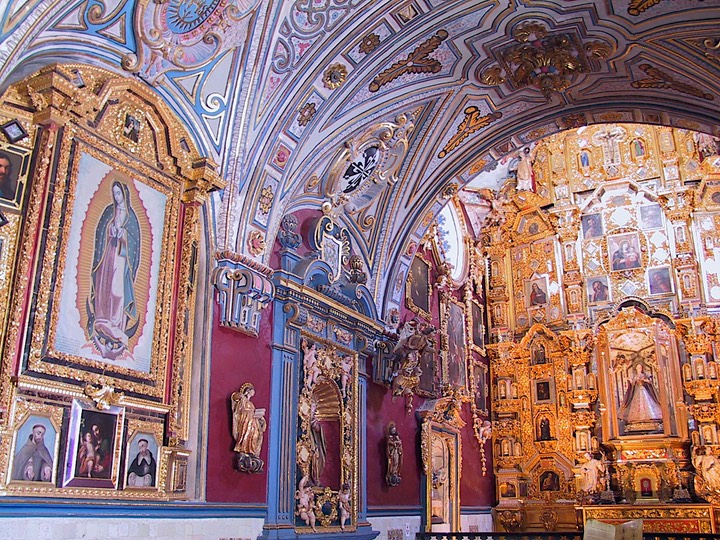
Our first night, with a next-day layover, was in Saltillo, an industrial city that had a pretty town square. We saw the square coming in, although we were camped way out of town, because our group got thoroughly lost (we were not the leaders) and our 6 mostly large, long motorhomes went through the center of town along many, many tiny, short itty-bitty little streets. We finally were rescued by a couple of policemen on bicycles, who led us to safety. More adventure than we had requested! The next day we took a city bus into the center of town, and walked around getting a sense of Mexican life on market day. The bus ride was a hoot: full of locals going about their business and us feeling very different (and large!). But they were friendly and helpful; one woman was on the bus with us at the end of the day who had been on the bus going in in the morning, and she smiled and laughed and made sure we all got off at the right spot. Sadly, the ride took us through what for them was a new housing project but which for us was a pretty squalid little area, with rubble and cars in the front yards, garbage and animals around, and little to recommend it. But the people were great: going home in the evening lots of young families and people carrying bundles. Polite and friendly. In Saltillo we joined with the rest of our rally folks; now we were 90-odd rigs strong, quite an impact wherever we landed.
We spent our next night on the road in a small town (which we overwhelmed with all those rigs), and then moved on to the delightful city of Queretaro, the capital of the State of Queretaro.
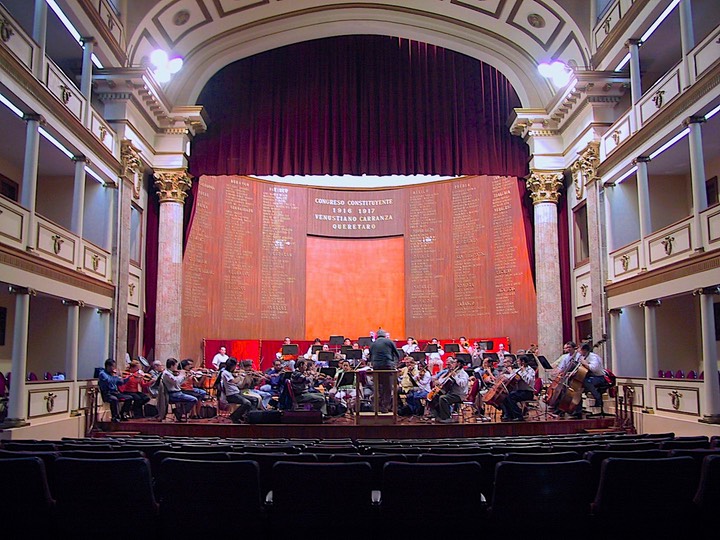
This was a beautiful city, cleaner than Saltillo, not industrial, a charming colonial town with lovely squares and statues, cathedrals that charmed, and food to enjoy. Rick had trouble throughout Mexico because the food wasn’t what he had hoped for, but in Queretaro we discovered tortas, a sandwich kind of a thing that was made right in front of you so you could pick out what to put in it. They were really yummy. With tummies filled at last, we happily wandered, and discovered a wonderful thing: In Queretaro that evening there was to be a concert in the Teatro de la Republica, the philharmonic orchestra was going to be performing Rachmaninoff and Beethoven, and there were two tickets left – really, we got the last two seats! So……….of course we grabbed them and made our plans. It was a real treat, and quite exciting. Our tickets were in the front row, not the first choice of serious classical event-attendees, but they were quite unique. We had a clear view of the conductor the entire evening and he was wonderfully expressive and communicative; his relationship with his excellent orchestra was very good (lots of smiles and hand shaking and grins), and we got to enjoy it close up.
It was a great evening. The hall was full of families, including several small children, all well behaved. The concert was one in a series of nine consecutive Friday night events doing all the Beethoven symphonies, along with other pieces, underwritten by various entities, just like at home. We had gone to the theater in the afternoon to get tickets, and the orchestra was in rehearsal, so Rick was able to take a picture of this wonderful old colonial building, in good light, with the players hard at work. As the concert didn’t begin until 8:30 in the evening, we took a taxi to and from town – we were staying several miles outside the city. Taxis are cheap in Mexico, although the communication is difficult, and Rick enjoyed being masterful about the amount of money we were willing to pay. We very much enjoyed our time (parts of 3 days) in Queretaro, and will be back to see more of the city. That area in Mexico has several wonderful towns, and we want to explore it further.
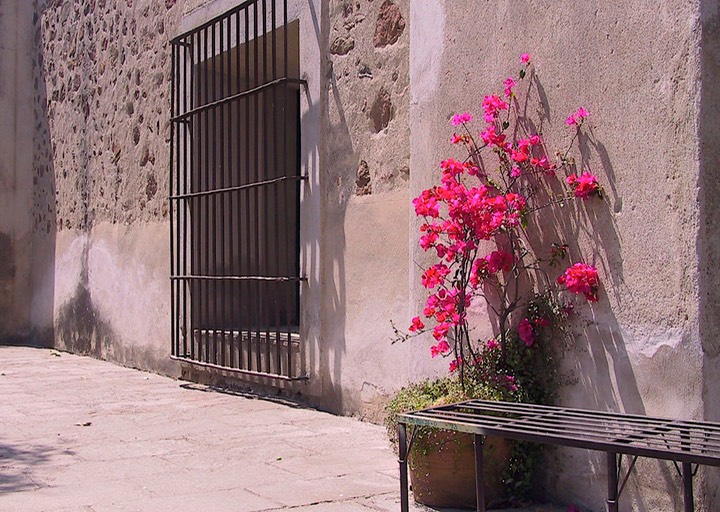
Still with the group, we moved on to a small town outside Mexico City (Tepotzotlan), where the rally actually took place, and where we stayed for a week. The countryside in this part of Mexico is very dry; there is little surface water (no lakes anywhere), but still we saw a few wildflowers. Tepotzotlan only has about 40,000 people, so it wasn’t as overwhelming as some towns. We could walk downtown from our site and still have enough energy left to see the cathedral and market areas. There was, unfortunately, a lot of rubble in the streets and along the sidewalks. It’s a combination, we decided, of projects underway and those left uncompleted. We assume this is a relatively prosperous town, being so close to Mexico City, but all the work underway made it seem very messy. Also, in Mexican towns, the shops are really little more than what looked like garages along the street, open to the public with goods available, including small groceries and pharmacies, then shut down at night. We saw little in the way of the more familiar storefront-type businesses. But there were lots of places to buy things, including clothing as well as business store items. And we saw plenty of places where cars were being worked on; there seemed to be no zoning at all, and businesses, homes and repair shops were all cheek to jowl.
The market area was quite large, with several produce stands, stalls with goods, and places to buy all kinds of foods. It was here that Rick discovered the Mexican ices of which he grew very fond. They easily became an entire meal. As mentioned, we visited the local cathedral, an incredibly gold-filled, gaudy paen to the Catholic church. There was also a splendid museum in the complex of buildings attached to the cathedral, built as a monastery by the Jesuits between 1606-1750. You could see the changes in architecture during the course of construction. It was marvelous. Part of the original Jesuit library is there, intact, behind barricades. How wonderful to see books so old!
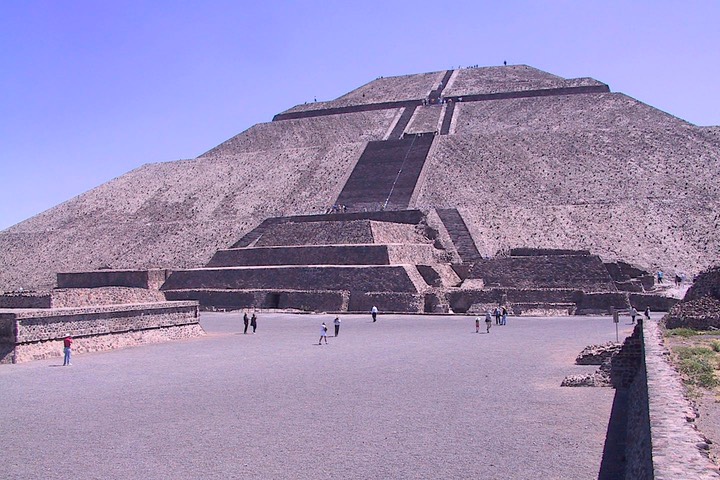
The Mexican national and local elections took place while we were in the country, and the week prior to voting day (a Sunday) was filled with loudspeaker-ed cars driving slowly through the streets, late night campaign parties, and every wall in town covered with campaign slogans – painted on the walls, not banners that could be removed later. And we were told that nobody bothers to repaint the walls between elections, so many of these “decorations” might possibly remain for years. They were very colorful, with the brightly colored advertising contrasting nicely with the whitewashed walls, but for years? No thanks!
During our time at Tepotzotlan, we did some sightseeing. We took a trip to some early ruins near Mexico City, the pyramids of Teotihuacan, which were very impressive. I climbed to the top, wiping myself out for the rest of the day, while Rick took pictures of me at various levels (in case I didn’t make it all the way?). This was also the place where Quetzcoatl’s temple is located, a name which may mean something to some of you. In telling you about our trip, we aren’t trying to fill in the details of Mexican history that go with the sights we saw; it’s too complicated. But suffice it to say that these were really early ruins, and really cool.
On two separate days we made tour trips into Mexico City, seeing the Museum of Anthropology, the floating gardens of Xochimilco (filled with Sunday family gatherings); and the Zocolo (the ancient town square). The Zocolo was really neat; it contains some of the best of the colonial architecture, along with the National Cathedral. The presidential palace is along the square, and we had intended to go in and see the (promised) wonderful Diego Riviera murals; alas, it was closed because of a HUGE, HUGE mob milling around outside. They were strikers protesting something; the square was filled with riot police. We kind of moved on along, thinking it might be smart to get out of there; our guide, on the other hand, seemed totally unconcerned….. An interesting sight in the square was a group of men in Aztec dress, adhering to the old, pagan ways and carrying on with their rituals (no sacrifices, however). One of them seemed like a kind of shaman; people would come to him, give him a few pesos, and he would do a ritual exorcising of the bad devils, using smoke and hand gestures. Neat.
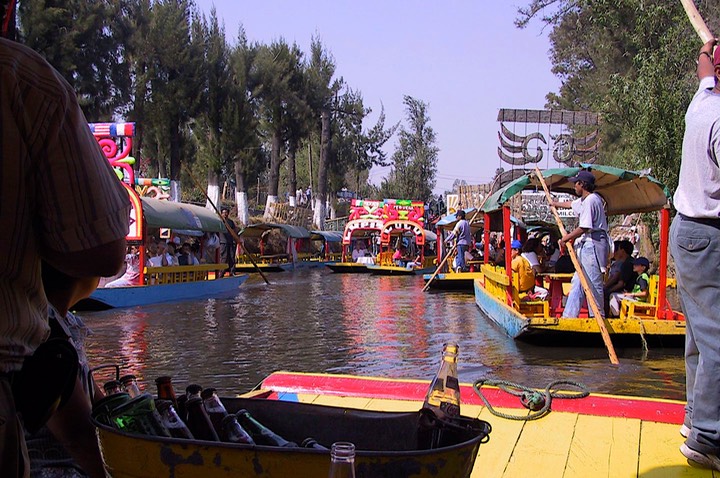
Our group gathering ended in Tepotzotlan; we had a nice dinner with dancing (Rick and I even got out on the floor – in our tennies; you would have been amused) and the next day we headed out on our own to see what we could see. We were soooooooo determined to strike off on our own after two whole weeks with this huge group of people. It led us on a wild adventure, trying to get over to the Gulf of Mexico coast without going through the Mexico City outskirts, which we knew to be very busy, difficult driving. The ultimate answer was – you can’t get there from here. We ended up on zillions of little yellow (secondary) roads that would peter out to nothing or take us into little old towns and then abandon us there, sending us in circles. At the end of the day we had gone 123 mostly bumpy miles in 8 and a half hours. We ended up retracing our steps and doing what had been advised in the first place (we had been determined there was a better way – WRONG!). At the end of the day we stopped to do some grocery shopping before heading to a campground we had identified. As we were about to leave the parking lot, we saw five of our fellow travelers in convoy, heading in the same direction. They had been doing the same thing all day as we had, although on a slightly different path, following someone using his GPS. So much for that idea!
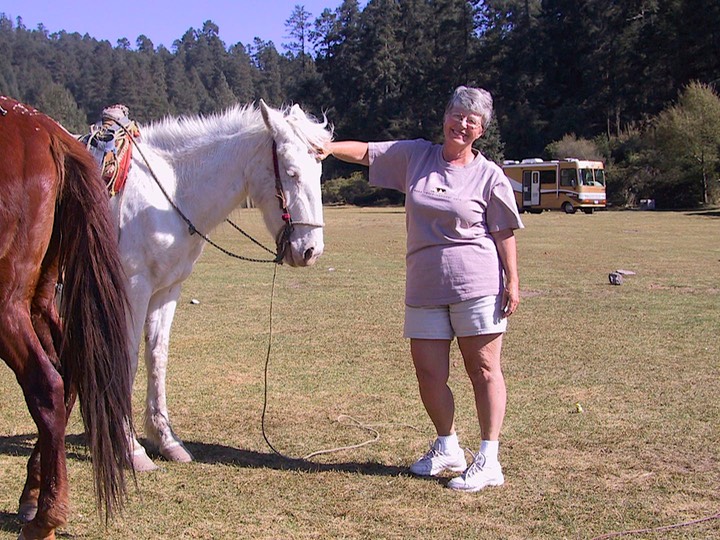
We spent that night in the national park above the city of Pachuca, and had a grand time. We were up over 9000 feet at least, and it was cool and lovely, in an area filled with pine trees. Mexican national parks are pretty undeveloped, and our spot was really just an open field with a couple of trash cans nearby. There were several university students (from Pachuca) hanging out, celebrating Friday afternoon. They came over and made friends and we had a great chat. We were trying to practice our Spanish and they wanted to practice their English. A good time was had by all.
The next day we pursued our goal of getting over to the Gulf of Mexico, dropping from over 9000 feet down to sea level during the course of the day, traveling through incredibly beautiful countryside as the area changed from semi-desert to sub-tropical, through tons of agriculture, constantly changing arrays of flowering trees and plants, burros by the road carrying small loads, etc. Just as you would have predicted. It was really cool. We were in very rural, very out-of-the-way Mexico. We were definitely off the beaten track. And it was great.
We spent several days on the coast (called the Emerald Coast, and it was gorgeously green, a lot like Hawaii), in a little campground directly on the beach. It was perfect. Beautiful clean sandy beach, and a lovely pool to clean off in afterwards, bougainvillea in full bloom, etc. We made friends with two Canadian couples who were also there. We sold our guide to Mexican campgrounds to a fellow traveling alone who was headed south (an interesting soul; divorced fellow about our age, looked very weathered – pony tail and no shirt – but fun to talk to; headed for Costa Rica actually, to start a new life; his ex-wife’s boat is in dry dock there…………..) because we were headed north and presumably didn’t need it (but of course we could have used it several times).
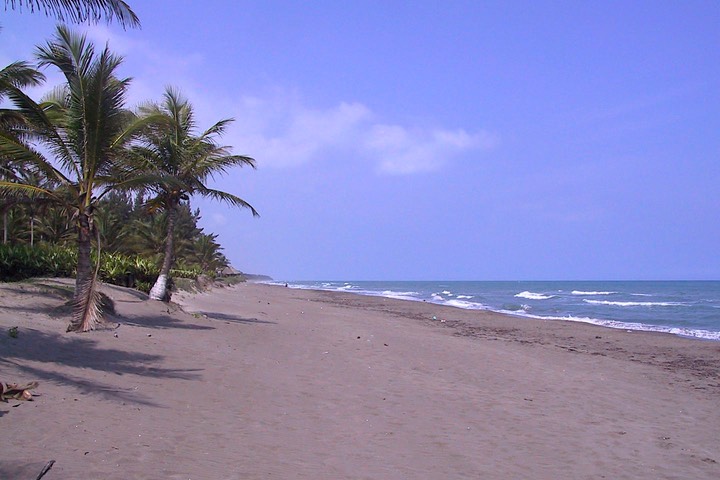
We hated to leave that campground, but I think Rick and I both were ready to get back to the real world, so decided to head on up the hill and back to the States. At about that time our ATM card stopped working, too. A problem on the bank’s end, but we were about out of money. Leaving the coast, we stopped at some extremely impressive ruins, El Tajin, and then we traveled through a long stretch of countryside filled with citrus orchards and corn. The smells of the trees in bloom was incredible. Part of this stretch was called the Valle de les Naranjes (valley of the oranges); it is probably the largest citrus production area in Mexico. They were picking, and we followed endless trucks heading to the packing sheds. It was colorful and fun. Further along, we went up through a sugar cane area, also being cut (with one humongous belching factory – yuck!). We went on through Cuidad Victoria (we simply spent the night, not spending much time in the city at all) and back into the States by way of the Pharr international bridge crossing just east of Reynosa; no trouble at the border. They weren’t very interested in us; we had been told the crossing could be quite difficult, with them entering and searching coaches right and left, and X-raying them (presumably for illegal aliens). We had put together all kinds of paperwork, including information detailing that the cats were ours and had been certified as in good health. Evidently, people tend to take pity on the scrawny cats and dogs they see across the border, trying to bring them back “to a better life” but bringing disease and other yucky stuff with them. But we were across in minutes, and on our way to a store where we could buy a new toilet – ours was on its last legs. We had survived our first foray into Mexico, both we and the cats were all still on speaking terms, nothing was broken, lost or damaged, what more can we ask?
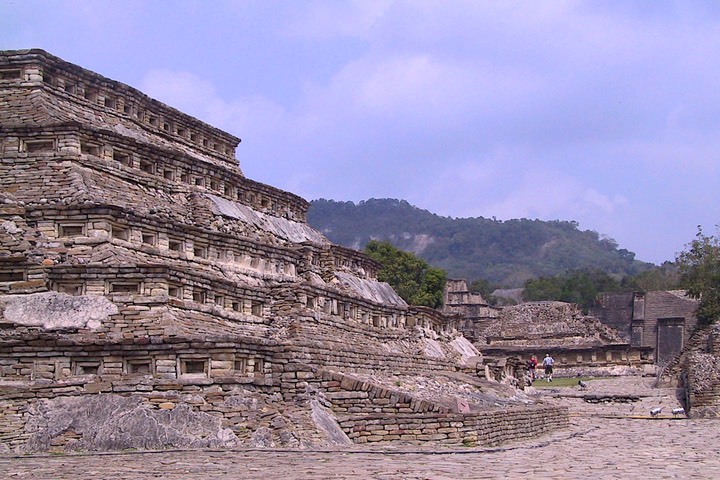
New commode installed, we headed for South Padre Island, where some friends were camped. WE DIDN’T KNOW IT WAS SPRING BREAK. But we survived, mostly by staying away from the places where the kids were headed. But we did spend an amazing morning doing our grocery shopping and watching the beer being put into the backs of the pickups. Our friends showed us good birding spots and shared their birding expertise. They also took us to the Brownsville zoo, which is world class and great fun. We got to see some Galapagos tortoises up close; something else! Our camping spot was right on the water, with an unimpeded view for miles and miles; this is the same Gulf of Mexico coast we were swimming in about 800 miles south, and the same water we had waded in in Apalachicola , Florida, on our way to Texas. That water gets around!
Leaving the southern tip of Texas, we headed north through Houston and back up to Livingston. We spent a night at Lake Texana, a very pretty state park (all the Texas state parks are pretty), camped right beside the water and a sign saying watch out for alligators and poisonous snakes. Needless to say, we didn’t swim here, although we did manage to see a snake and an armadillo! The road the next day took us past the little town of Van Vleck, home of the Texas girls’ state power lifting champions. You go, girls…………. Outside Houston, we stopped at the San Jacinto Battlefield State Historic Site, an important place in the history of Texas’ fight for independence from Mexico. It has a very impressive monument and presentation. Well worth the stop. And it’s spring out there! All the countryside is in bloom, with trees in bud and the Texas bluebonnets everywhere; they look very like our lupine, and bloom in the same large patches in the fields. We’d frequently pass large patches of mixed colors with four or five different blooms competing for our attention. Quite a sight.
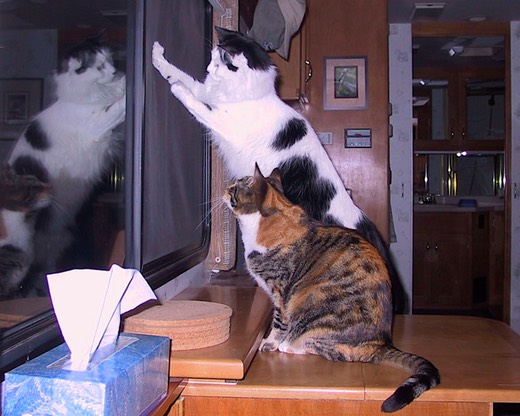
We’re back in Livingston now, gathering up our trailer and motorcycle and preparing to head west. We do so love this new life of ours (can you tell?), and we’ve decided it’s time to head back to California and sell our house in Paso Robles. So you can look for us on the horizon in mid-April. We’ll be the ones trying to pry everything back out from underneath the house in order to prepare to get it all sold and get the house on the market. We should be around for a month or so, and will hope to see you somewhere.
Til then,
Hugs, Kathy and Rick
Click here for more pictures from Mexico.